Part 3
| Monday,
May 5 | (Lecture #28) |
|---|
Today we concentrate on calculus in polar coordinates. First, though,
let's sketch some polar coordinate curves to get some idea of what we
will be doing. In class I did examples with cosine. Here are similar
examples with sine.
A collection of examples
r=3+sin(θ)
Let's consider r=3+sin(θ). Since the values of sine are all
between -1 and 1, r will be between 2 and 4. Any points on this curve
will have distance to the origin between 2 and 4 (the green and red
circles on the accompanying graph). When θ=0 (the positive x-axis)
r is 3. As θ
increases in a counterclockwise fashion, the value of r increases to 4
in the first quadrant. In the second quadrant, r decreases from 4 to
3. In the third quadrant, corresponding the sine's behavior (decrease
from 0 to -1) r decreases from 3 to 2. In all of this {in|de}crease
discussion, the geometric effect is that the distance to the origin
changes. We're in a situation where the central orientation is what
matters, not up or down or left or right. Finally, in the fourth
quadrant r increases from 2 to 3, and since sine is periodic with
period 2Pi, the curve joins its earlier points.
The picture to the right shows the curve in black. I'd describe the
curve as a slightly flattened circle. The flattening is barely
apparent to the eye, but if you examine the numbers, the up/down
diameter of the curve is 6, and the left/right diameter is 6.4.
| 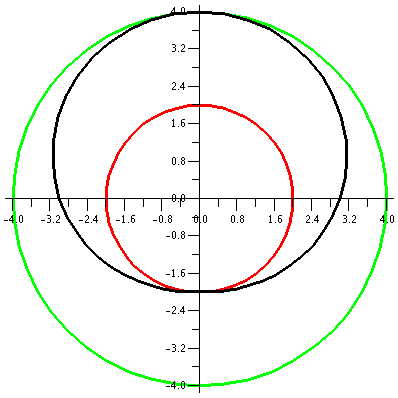
|
Converting to rectangular coordinates
A naive person might think, "Well, I could convert the equation
r=3+sin(θ) to rectangular coordinates and maybe understand it
better." Except under rare circumstances (I'll show you one below),
the converted equation is very irritating and difficult to
understand. For example, Let's start with r=3+sin(θ) and
multiply by r. The result is r2=3r+r·sin(θ). I
multiplied by r so that I would get some stuff I'd recognize from the
polar/rectangular conversion equations. r2 is
x2+y2 and r·sin(θ) is y. So I have
x2+y2=3r+y, or
x2+y2-y=3r. I would rather avoid square roots so
I will square this, and get
(x2+y2-y)2=9r2=9(x2+y2).
This is a polynomial equation in x and y of highest degree 4, defining
this curve implicitly. I don't get much insight from this.
|
r=2+sin(θ)
Now consider r=2+sin(θ). Again,
the values of sine are all between -1 and 1, so r will be between 1
and 3. Any points on this curve will have distance to the origin
between 1 and 3. We can begin (?) the curve at θ=0 when r=2, and spin around
counterclockwise. The distance to the origin increases to r=3 at θ=Pi/2 (the positive y-axis). The
distance to the origin decreases back to r=2 when θ=Pi (the negative x-axis). The
curve gets closest to the origin when θ=3Pi/2 (the negative y-axis) when r=1. Finally, r increases
(as θ increases in the
counterclockwise fashion) to r=3 again when θ=2Pi.
Here the "deviation" from circularity in the curve is certainly
visible. The bottom seems especially dented.
| 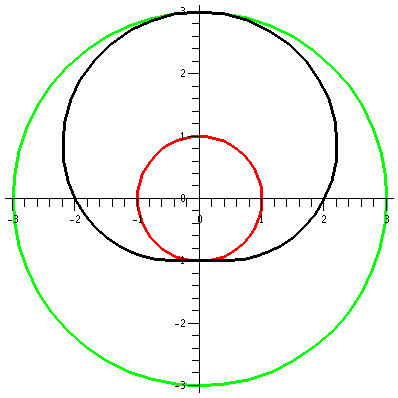
|
r=1+sin(θ)
We decrease the constant a bit more, and look at r=1+sin(θ). The values of sine are all
between -1 and 1, so r will be between 0 and 2. The (red) inner circle
has shrunk to a point. This curve will be inside a circle of radius 2
centered at the origin. We begin our sweep of the curve at 0, when r
is 1. Then r increases to 2, and the curve goes through the point
(0,2). In the θ interval from
Pi/2 to Pi, sin(θ) decreases
from 1 to 0, and the curves moves closer to the origin as r decreases
from 2 to 1. Something rather interesting now happens as θ travels from Pi to 3Pi/2 and then
from 3Pi/2 to 2Pi.  The rectangular graph of 1+sine, shown here, decreases
down to 0 and then increases to +1. The polar graph dips to 0 and then
goes back up to 1. The dip to 0 in polar form is geometrically a sharp
point! I used "!" here because I don't believe this behavior is easily
anticipated. The technical name for the behavior when r=3Pi/2 is
cusp. The rectangular graph of 1+sine, shown here, decreases
down to 0 and then increases to +1. The polar graph dips to 0 and then
goes back up to 1. The dip to 0 in polar form is geometrically a sharp
point! I used "!" here because I don't believe this behavior is easily
anticipated. The technical name for the behavior when r=3Pi/2 is
cusp.
This curve is called a cardioid from the Latin for "heart"
because if it is turned upside down, and if you squint a bit, maybe it
sort of looks like the symbolic representation of a heart. Maybe.
| 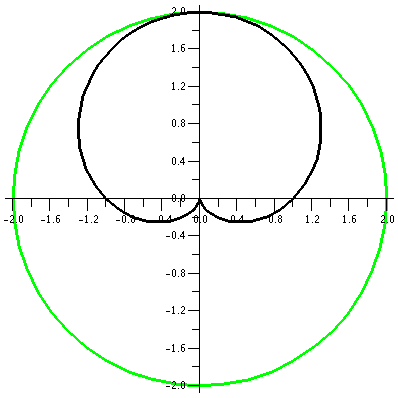
|
r=1/2+sin(θ)
Let's consider r=1/2+sin(θ). The values of sine are all
between -1 and 1, so r will be between -1/2 and 3/2. The (red) inner
circle actually had "radius" -1/2, and it consists, of course, of
points whose distance to the pole, (0,0), is 1/2. When θ is 0, r is 1/2. In the first two
quadrants, 1/2+sin(θ) increases
from 1/2 to 3/2 and then backs down to 1/2. In the second two
quadrants, when θ is between Pi
and 2Pi, more interesting things happen.
 The rectangular graph on the interval [0,2Pi] of sine moved up by 1/2
shows that this function is 0 at two values, and is negative between
two values. The values are where 1/2+sin(θ)=0 or sin(θ)=-1/2. The values of θ satisfying that equation in the
interval of interest are Pi+Pi/6 and 2Pi-Pi/6. The curves goes down to
0 distance from the origin at Pi+Pi/6, and then r is negative until
2Pi-Pi/6. The natural continuation of the curve does allow negative
r's, and the curve moves "behind" the pole, making a little loop
inside the big loop. Finally, at 2Pi-Pi/6, the values of r become
positive, and the curve links up to the start of the big loop.
The rectangular graph on the interval [0,2Pi] of sine moved up by 1/2
shows that this function is 0 at two values, and is negative between
two values. The values are where 1/2+sin(θ)=0 or sin(θ)=-1/2. The values of θ satisfying that equation in the
interval of interest are Pi+Pi/6 and 2Pi-Pi/6. The curves goes down to
0 distance from the origin at Pi+Pi/6, and then r is negative until
2Pi-Pi/6. The natural continuation of the curve does allow negative
r's, and the curve moves "behind" the pole, making a little loop
inside the big loop. Finally, at 2Pi-Pi/6, the values of r become
positive, and the curve links up to the start of the big loop.
This curve is called a limacon. The blue lines are lines with
θ=Pi+Pi/2 and θ=2Pi-Pi/6. These lines, for the θ
values which cross the pole, are actually tangent to the curve at the
crossing points.
| 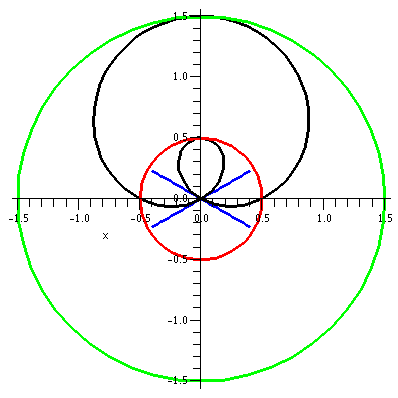
|
r=0+sin(θ)
Let's try a last curve in this family, with the constant equal to
0. What does r=sin(θ) look like? A graph is shown to the right.
There are several interesting features of this graph. First, this is a
polar curve which does have a nice rectangular (xy) description. If we
multiply r=sin(θ) by r, we get
r2=r·sin(θ), so that
x2+y2=y. This is x2+y2-y=0
or, completing the square,
x2+y2-2(1/2)y+(1/2)2-(1/2)2=0
so that (x-0)2+(y-1/2)2=(1/2)2. This
is a circle of radius 1/2 and center (0,1/2), exactly as it looks.
The moving "picture" of this curve is quite different. Between
0 and π it spins once around the circle but then from π to 2π
it goes around the circle another time! So this is really somehow two
circles, even though it looks like only one geometrically.
| 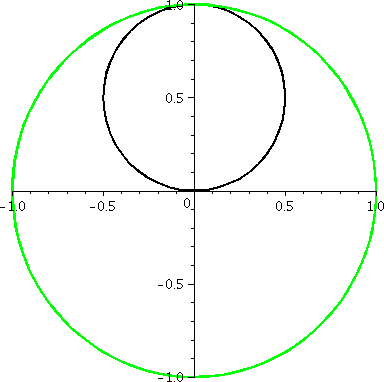
|
More information about these curves is available here
Length of polar curves
The formula is
∫θ=αθ=βsqrt(r2+(dr/dθ)2)dθ. I used this to find the length of the
cardioid above (the double angle formula from trig is needed). Then I
used it to find the length of a circle (!), but here the novelty is
that we actually trace the circle r=cos(θ) twice from 0
to 2π, so some care is needed if we only wanted to find the length
of one circumference.
"Sketching" roses
Here are dynamic pictures of two roses. The first is the one I
sketched in class r=cos(3θ). It is covered twice and has 3
"petals". The second is r=cos(4θ). It is only covered once, and
it has 8 petals! Wow, polar coordinates can be annoying!
r=cos(3 )
This is a three-leafed rose. Please note that the graph shows one
sweep, as θ goes from 0 to 2Pi. )
This is a three-leafed rose. Please note that the graph shows one
sweep, as θ goes from 0 to 2Pi.  The
rectangular graph, shown here, has three pairs of ups and downs. The
polar trace covers the leaves twice. The six up-and-downs of
cos(3θ) (magically?) reduce to retracings of half of the
loops. I hope I made this evident. I introduced
some deliberate distortion in the second tracing. (!) Without
the distortion, the second tracing could not be seen at all, since the
pixels the "point" travels over and colors all had already been
colored. The
rectangular graph, shown here, has three pairs of ups and downs. The
polar trace covers the leaves twice. The six up-and-downs of
cos(3θ) (magically?) reduce to retracings of half of the
loops. I hope I made this evident. I introduced
some deliberate distortion in the second tracing. (!) Without
the distortion, the second tracing could not be seen at all, since the
pixels the "point" travels over and colors all had already been
colored.
| 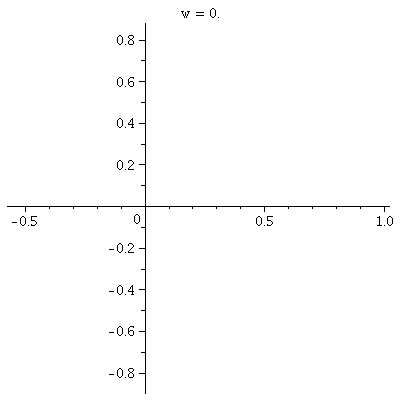
|
r=cos(4θ)
This "rose" has 8 leaves or petals, and
the dynamic way it is traced is weird and wonderful to me.  The rectangular
graph. to the right, shows four bumps up and four bumps down. There
are no retracings of already colored points, so that the wiggles up
and down of cos(4θ) all result in 8 leaves. The rectangular
graph. to the right, shows four bumps up and four bumps down. There
are no retracings of already colored points, so that the wiggles up
and down of cos(4θ) all result in 8 leaves.
| 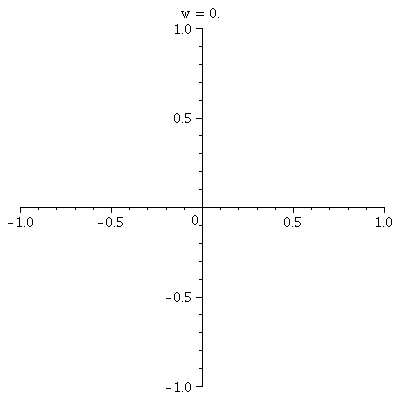
|
 Area inside one petal of r=cos(3θ)
Area inside one petal of r=cos(3θ)
Well, cos(3θ) "first" (going from 0 to 2π) is 0 when
3θ=π/2. So we get half a petal by integrating from 0 to
π/6. The formula is
∫αβ(1/2)r2dθ so
this becomes (for the whole petal, we need to double):
2·(1/2)∫0π/6
cos(3θ)2dθ. We computed this using a trig
identity.
r=cos(3θ). Area inside one petal?
I didn't talk about Exponentials and snails, darn it!
| Wednesday,
April 30 | (Lecture #27) |
|---|
 Tangent lines
Tangent lines
I'll find the tangent lines at the self-intersection point of my favorite curve. The point involved is (1/2,0) and
the two values of t are +1 and -1. Since I have the point, the other
information I need to find the tangent lines is the slope. Well, slope
is dy/dx=dy/dt/dx/dt.
Since x=1/(1+t2),
dx/dt=(-2t)/(1+t2)2. I only fouled this up two
or three times in class, but when t=-1, dx/dt=1/2, and when t=+1,
dx/dt=-1/2.
Since y=t3-t, dy/dt=3t2-1. When t=-1 or when
t=+1, dy/dt=3-1=2.
Therefore when t=-1, dy/dx=(2)/(1/2)=4. The line goes through (1/2,0),
so an equation for it is y=4(x-1/2).
Therefore when t=1, dy/dx=(2)/(-1/2)=-4. The line goes through (1/2,0),
so an equation for it is y=-4(x-1/2).
I had Maple graph the parametric curve
and the two lines just found (in green and
blue. I then asked what the angle between the
lines (the angle which encloses the x-axis). Then, I waited, as more
seconds of the 21st century ticked by. Some time (and more
words later) we decided that the angle was 151.9 degrees. Hey, please
remember that the slope of a line is the tangent of the angle that the
line makes with the positive x-axis. Here the line y=4(x-1/2) and the
positive x-axis have angle equal to arctan(4), approximately 1.326
radians. Double this is about 151.9 degrees. Hey: you have the
machines. Please use them.
Uniform speed?
We developed a formula for speed. It was
sqrt(f´(t)2+g´(t)2) where x=f(t) and
y=g(t). For the circle x=5cos(t) and y=5sin(t), previously considered, we know dx/dt=-5sin(t) and
dy/dt=5cos(t), so that (dx/dt)2+(dy/dt)2=25((sin(t))2+(cos(t))2)=25·1=25, so the speed, which is the square
root, is always 5. So this is uniform circular motion: the word
"uniform" here means that the speed is constant. (Notice, oh physics
people, that I am not saying the velocity is constant and I am not
saying that the acceleration is 0. Indeed, both of those statements
are false. The direction of the velocity is changing, so the
acceleration is not 0. We need to look at these quantities as
vectors, and this will be done in Math 251.)
Nonuniform speed
Then I tried to analyze an ellipse we had parameterized
earlier. It turns out that what I wrote and said in the last
lecture was incorrect. I am sorry. So: we have x(t)=5cos(t) and
y(t)=3sin(t) so dx/dt=-5sin(t) and dy/dt=3cos(t), and the speed is the
square root of 25(sin(t))2+9(cos(t))2=
16(sin(t))2+9(sin(t))2+(cos(t))2=
16(sin(t))2+9. Sigh. The speed at time t is
sqrt(16(sin(t))2+9). When t=0, the particle whose motion we
are describing is at (5,0) and the speed is sqrt(9)=3 since
sin(0)=0. When t=&pi/2, the particle is at (0,3) and the speed is
sqrt(25)=5 since sin(&pi/2)=1. So certainly the particle is not moving
at the same speed. Indeed, a graph of the speed,
sqrt(16(sin(t))2+9), is shown to the right.
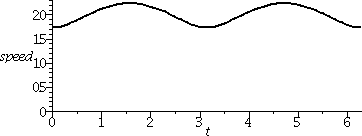 Now this does resemble what I know about the motion of a planet in
orbit. When it is far away from the center of the orbit, the planet
will have large potential energy and relatively small kinetic energy
(it will move slowly). This is near t=0 and t=π. When it is close
to the center of the orbit, the planet moves faster, and the kinetic
energy is larger, while the potential energy, measured by the work
needed to move closer/farther from the center, decreases.
Now this does resemble what I know about the motion of a planet in
orbit. When it is far away from the center of the orbit, the planet
will have large potential energy and relatively small kinetic energy
(it will move slowly). This is near t=0 and t=π. When it is close
to the center of the orbit, the planet moves faster, and the kinetic
energy is larger, while the potential energy, measured by the work
needed to move closer/farther from the center, decreases.
The total energy is conserved, but the way the total is divided
between kinetic and potential energy varies. Maybe if you look
again at the moving picture, you will see both of these phenomena. It
is not too clear to me.
Length of a curve
Well, suppose we move along a parametric curve given by x=f(t) and
y=g(t) from t=START to t=END. If we believe that the
speed is sqrt(f´(t)2+g´(t)2), then we
know that this speed can vary. In a sort time interval (dt long!) the
distance traveled is Speed·Time, or
sqrt(f´(t)2+g´(t)2)dt. We can add up
all these distances from t=START to t=END using the
integral idea. So the distance traveled along the curve from
t=START to t=END will be given by
∫t=STARTt=ENDsqrt(f´(t)2+g´(t)2)dt.
(We are integrating the magnitude of the velocity vector). Is this a
reasonable formula?
Back to my favorite curve
The length of the loop in my favorite curve can be gotten by computing
the integral of the speed from -1 to +1 (the two self-intersection
times). So this is (I'll use the formulas we already have)
∫-11sqrt((-2t/(1+t2)2)2+(3t2-1)2)dt.
Maple takes more than half a second
(quite a lot of time!) to acknowledge that it can't find an
antiderivative, so we can't use FTC. In less than a tenth of a second,
the approximate value 1.971944073 is reported.
Almost no speed functions have nice, neat, simple antiderivatives. In
the real world, you'll need to use numerical approximation. However,
Math 152 is not the real world.
A textbook problem
Section 11.3, problems 3 through 15, are all "Find the length of the
path over the given interval" with some rather silly-looking functions
specified. Accidentally (exactly not accidentally, actually!)
all of the problems can be computed exactly with antiderivatives and
values of standard functions. There is a fair amount of ingenuity
involved in constructing such examples. I urged students to practice
with several of them. I invited a suggest, and #7 was suggested. Here
it is:
Find the length of the path described by
(3t2,4t3), 1≤t≤4.
The solution
Here x=3t2 and y=4t3. We will compute the speed
and then attempt to "integrate" (actually using FTC, so we'll need to
find the antiderivative). Now dx/dt=6t and
dy/dt=12t2. Therefore the speed is sqrt(6t)2+(12t2)2). This is
sqrt(36t2+144t4). We'll need to integrate this,
and maybe I will "simplify" first. Indeed, since we consider t in an
interval where t≥0, sqrt(t2)=t (otherwise we would need
to worry about |t| or -t etc.). But
36t2+144t4=36t2(1+4t2) so
that the square root is 6t·sqrt(1+4t2). Therefore
the distance traveled along the curve is an integral,
∫t=1t=46t·sqrt(1+4t2)dt.
Several students immediately suggested various substitutions. Here is
one which does the job efficiently. So:
If u=1+4t2, du=8t dt, so (1/8)du=dt.
∫6t·sqrt(1+4t2)dt=(6/8)∫sqrt(u)du.
The several errors made by the lecturer in class are not, I hope,
duplicated here.
Now
(6/8)∫sqrt(u)du=(6/8)(2/3)u3/2+C=(1/2)u+C=(1/2)(1+4t2)3/2+C.
So
∫t=1t=46t·sqrt(1+4t2)dt=(1/2)(1+4t2)3/2|14=(1/2)(65)3/2-(1/2)(5)3/2.
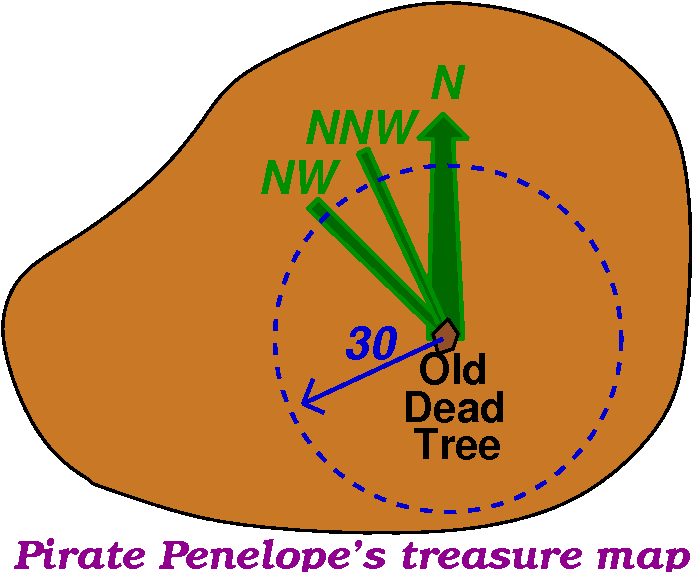 The idea of polar coordinates
The idea of polar coordinates
You have found a treasure map supposedly giving directions to the
burial spot of a chest full of gold, jewels, mortgages, etc., stolen
by the Dread Pirate Penelope. The information you have is that
A buried treasure is located 30 feet from the
old dead tree, in a
NorthNorthWest direction.
So there you are, on the island. Perhaps the Old dead tree is
still visible. You could mentally draw a circle 30 feet in radius
around the Old Dead Tree. Then you find the North
direction. π/4;=45o to the West is NW (Northwest) and
then NNW (Northnorthwest) is π/8 towards North (anyway, you decide
on the direction). Where that direction intersects the circle is
probably where to dig, unless Penelope is tricky, etc.
The whole idea of located a point in a 2-dimensional setting using
distance from a fixed point and angle with respect to a fixed
direction is called polar coordinates.
"Standard issue" polar coordinates
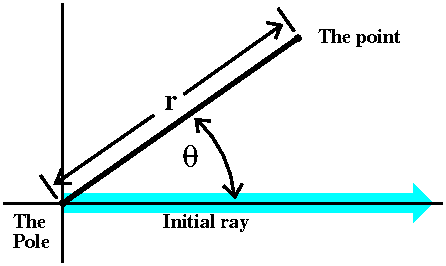 Fix a point (usually called "the center" or sometimes "the pole" and
in most common situations, the origin of the xy-coordinate
system. Also fix a direction -- if need this might be called "the
initial ray". Almost always this is the positive x-axis in an
xy-coordinate system. Then locate another point in the plane by giving
its distance from the center (called r) and by drawing the line
segment between the center and the point you are locating. Measure the
angle between that and the initial ray (note: counterclockwise is a
positive angle!): this is called θ. r and θ are the
polar coordinates of the point.
Fix a point (usually called "the center" or sometimes "the pole" and
in most common situations, the origin of the xy-coordinate
system. Also fix a direction -- if need this might be called "the
initial ray". Almost always this is the positive x-axis in an
xy-coordinate system. Then locate another point in the plane by giving
its distance from the center (called r) and by drawing the line
segment between the center and the point you are locating. Measure the
angle between that and the initial ray (note: counterclockwise is a
positive angle!): this is called θ. r and θ are the
polar coordinates of the point.
An example and the problem with polar coordinates
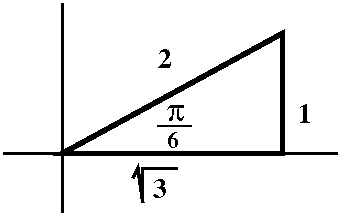 Well, make the standard choices for "the pole" and "the initial
ray". Let's get polar coordinates (the values of r and θ) for
the point whose rectangular coordinates are x=sqrt(3) and y=1. Of
course this is not a random point (sigh). So we consider the picture,
and decide that the hypotenuse (r) should be 2 units long, and the
acute angle (θ) should be π/6. Fine.
Well, make the standard choices for "the pole" and "the initial
ray". Let's get polar coordinates (the values of r and θ) for
the point whose rectangular coordinates are x=sqrt(3) and y=1. Of
course this is not a random point (sigh). So we consider the picture,
and decide that the hypotenuse (r) should be 2 units long, and the
acute angle (θ) should be π/6. Fine.
But suppose that the point (sqrt(3),1) is operating in a sort of
dynamic way. Maybe it is the end of a robot arm, or something, and
suppose that the arm is swinging around the pole, its angle
increasing. It might be true that we somehow are computing various
angles, and since the arm is moving continuously (still no teleporting
robot arms!) the angles which are θ's should change
continuously. If the arm swings completely around the pole, and comes
back to the same geometric location, it would make more sense to
report its polar coordinates as r=2 and θ=13π/6 (which is
better understood as 2π+π/6).
Some valid polar coordinates for the point whose rectangular
coordinates are x=sqrt(3) and y=1:
r=2 and θ=π/6 r=2 and θ=13π/6
r=2 and θ=25π/6 ETC.
But the "robot arm" could also swing around backwards, so other
possible polar coordinates for the same geometric point include
r=2 and θ=-11π/6 r=2 and θ=-23π/6
ETC.
Generally, r=2 and θ=&pi/6+2π(multiplied by any integer): the integer
could be 0 or positive or negative.
The irritation ("It's not a bug, it's a feature ...") is that there
are further "reasonable" polar coordinate pairs for the same point!
For example, go around to π/6+π. If you position your robot arm
there, and then tell the arm to move backwards 2 units, the arm will
be positioned at (sqrt(3),1). Sigh. So here are some more polar
coordinates for the same point:
r=-2 and θ=7π/6 and
r=-2 and θ=-19π/6
and r=-2 and θ=-31π/6 ETC.
but we are not done yet,
because there are also (going backwards in the angle and the
length)
r=-2 and θ=-5π/6 and
r=-2 and θ=-17π/6 and
r=-2 and θ=-29π/6 ETC.
Generally, r=-2 and θ=7&pi/6+2π(multiplied byany integer): the integer
could be 0 or positive or negative.
Common restrictions on polar coordinates and the problems they have
This is irritating. Any point in the plane has infinitely many valid
"polar coordinate addresses". In simple applications, people
frequently try to reduce the difficulty. Much of the time, we expect
r>0 always. And maybe we also make θ more calm. The
restriction 0<θ<2π is used, except when it isn't, so
the restriction -π<θ≤π is used in other
circumstances. I am not trying to be even more incomprehensible than
usual. I am merely reporting what different people do. As we will see,
this is all very nice, except that there are natural circumstances,
both in physical modeling (the robot arm I mentioned) and in the
mathematical treatment, where it will make sense to ignore the
artificial restrictions, even if this makes life more
difficult. You'll see a few of these circumstances.
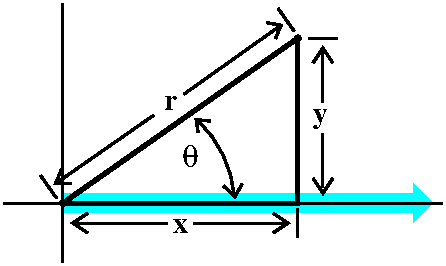
Conversion formulas
If you consider the picture to the right, I hope that you can fairly
easily "read off" how to go from r and θ to x and y:
x=r cos(θ)
y=r sin(θ)
The lecturer made another embarrassing mistake
here -- what's with him today?
Going from x and y to r is easy enough:
r=sqrt(x2+y2). If we divide the y equation above
by the x equation, the r's drop out and we get y/x=tan(θ) so
that θ=arctan(y/x). Please note that there are infinitely
many valid r and θ pairs for every point, so this method
will only give you one such pair! Be careful in real applications,
please.
Specifying regions in the plane in polar fashion
It is useful to try to get used to thinking in polar fashion, because
then you will be able to see problems (usually physical or geometric
problems with lots of central symmetry) where this coordinate system
can be used to really simplify computations. So here are some simple
examples of regions which can be easily specified with polar
inequalities.
|
1<r<3
r=1 and r=3 represent two circles centered at 0, one of radius 1 and
one of radius 3. The inequality, which has no restriction on
θ, means that every point between these circles is in the region
specified. This sort of region is frequently called an annulus.
|
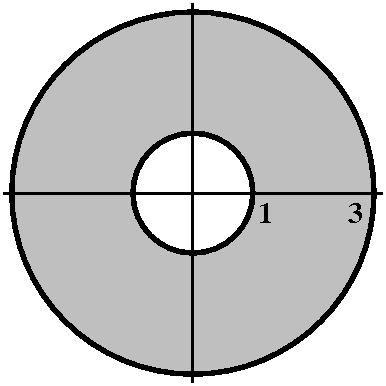
|
|
π/4<θ<π
Here there is no restriction on r. I will assume (!!) the standard
restriction that r should not be negative. Then a point is in this
region if its angle with respect to the positive x-axis is more than
π/4 and less than π (the angle π specifies the
negative x-axis!!!). I guess I would call this region a wedge.
I also "guess" that 0 is in this region. The wedge goes out radially
"to infinity" in all of the legal θ directions.
|
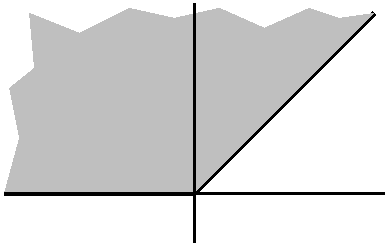
|
|
0<r<1 and π/2<θ<5&pi/4
Here are combined restrictions on both polar coordinates. I hope you
can "see" the geometric result. I could describe this region in
rectangular coordinates, certainly, but the needed equations and
inequalities would be much more complicated to me. Maybe this sort of
thing will give you some appreciation of the usefulness of polar
coordinates.
|
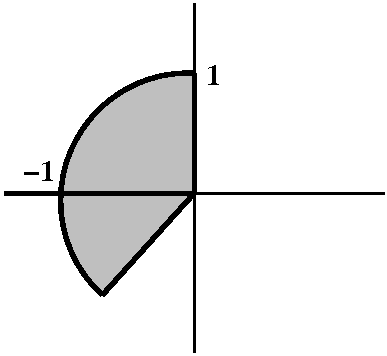
|
We will study the equations and graphs of some polar curves next time,
and we will do a bit of calculus (arc length and area). That will
conclude the course lectures.
| Monday,
April 28 | (Lecture #26) |
|---|
Reminders ...
Please on Thursday: go to class and work on the course coordinator's
review problems. Then next week come see me and we will review lots of
textbook problems at our review session.
Parametric curves
We begin our rather abbreviated study of parametric curves. These
curves are a rather clever way of displaying a great deal of
information. Here both x and y are functions of a parameter. The
parameter in your text is almost always called t. The simplest
physical interpretation is that the equations describe the location of
a point at time t, and therefore the equations describe the motion of
a point as time changes. I hope the examples will make this more
clear. The t here is usually described for beginners as time, but in
applications things can get a great deal more complicated. Parametric
curves could be used to display lots of information. I mentioned that
some steels contain chromium. Maybe the properties of the steel such
as ductility (a real word: "The ability to permit change of shape
without fracture.") and density, might depend on the percentage of
chromium. So the t could be that and the x and y could be measurements
of some physical properties of the steel. Here x=f(t) and y=g(t), as
in the text. Now a series of examples.
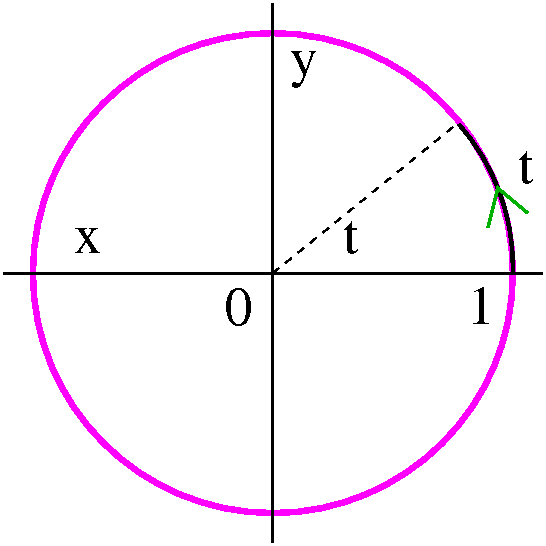 Example 1
Example 1
Suppose x(t)=cos(t) and y(t)=sin(t). I hope that you recognize almost
immediately that x and y must satisfy the equation
x2+y2=1, the standard unit circle, radius 1,
center (0,0). But that's not all the information in the equations.
The point (x(t),y(t)) is on the unit circle. At "time t" (when the
parameter is that specific value) the point has traveled a length of t
on the unit circle's curve. The t value is also equal to the radian
angular measurement of the arc. This is uniform circular
motion. The point, as t goes from -infinity to +infinity, travels
endlessly around the circle, at unit speed, in a positive,
counterclockwise direction.
Example 2
Here is a sequence of (looks easy!) examples which I hope showed
students that there is important dynamic (kinetic?) information in the
parametric curve equations which should not be ignored.
- x(t)=t and y(t)=t. Surely the "particle" travels on the main
diagonal line y=x. The travel (remember, the domain unless otherwise
limited, is all values of t which makes sense to the defining
functions) is from lower left (third quadrant) to upper right, (first
quadrant). Also I hope that you see the particle moves at uniform
speed. This is uniform linear motion.
| 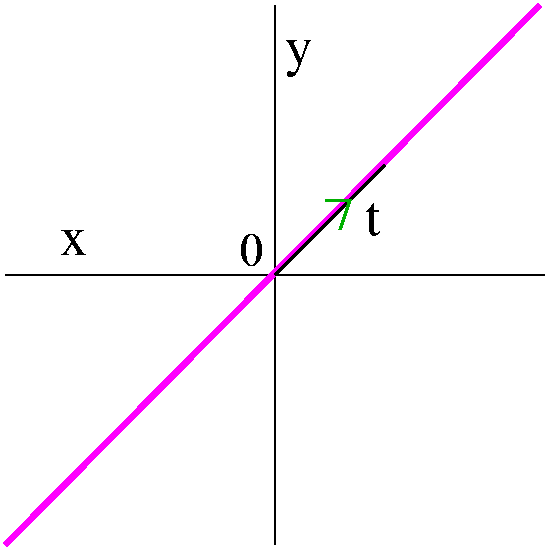
|
- x(t)=t3 and y(t)=t3. The path of this point
is also on the main diagonal line y=x. But the motion of this point,
while in the same direction as the first example (from third to first
quadrant), is very different. The difference is in the "clock". Try a
few values of t. Between t=0 and t=1 we travel from (0,0) to
(1,1). Between t=1 and t=2, we travel from (1,1) to (8,8). Just
roughly, the distance changes from sqrt(2) to sqrt(98). That's a big
change. The particle, near -infinity, travels fast. Then as t goes
around 0, it is slower, and, as t gets very large positive, the
particle moves faster.
| 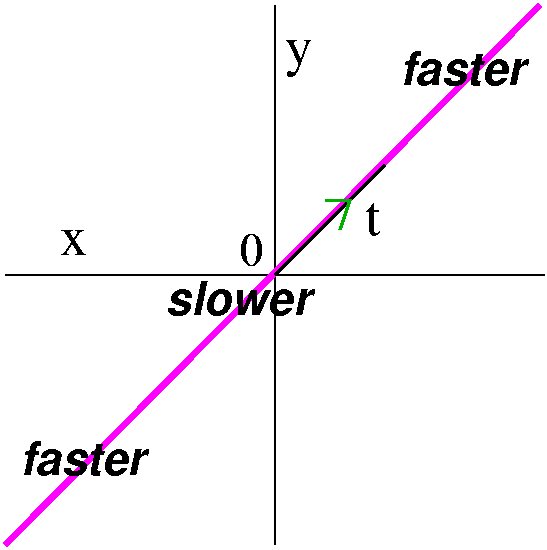
|
- Now let's consider the motion described by x(t)=t2 and
y(t)=t2. Again, we can "eliminate the parameter". That
rather grim phrase (if you read murder mysteries!) is what the text
uses to describe getting rid of t by manipulating the two
equations. Here we just realize that x=y. Much of the information
about the motion of this point on the main diagonal is lost if we go
to just y=x. The t2 means that both x and y must be
non-negative. When t is large negative, the point is way up high in
the first quadrant, and traveling towards the origin rather
rapidly. It begins to slow, and then "stops" (!) but only
"instantaneously" (!!) at (0,0) (when t=0). It turns around (how the
heck does a particle "turn around"?) and begins to retrace its path,
up towards the open end (??) of the first quadrant. As it travels, its
speed increases. So this is really quite complicated motion, and very different from the first two examples.
| 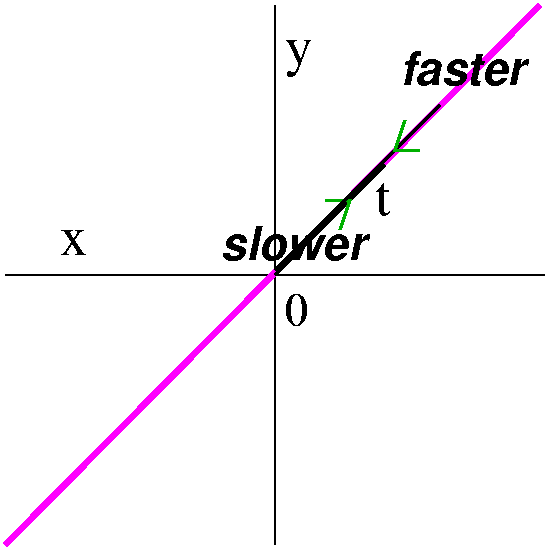
|
- The final example in this series is x(t)=cos(t), and
y(t)=cos(t). Again, the path traveled by the point is on the main
diagonal line y=x. But now the dynoamics are extremely
different. Because cosine oscillates endlessly between -1 and +1, the
motion of the point whose position is described by these equations is
on the line y=x and only between (-1,-1) and (1,1). It moves back and
forth between these points, completing a round trip in every time interval of length 2Pi. This is very different motion from the other examples.
| 
|
Example 3
I considered x(t)=5cos(t)and y(t)=5sin(t). This is a slight
variant of the very first example. Since x(t)/5=cos(t) and
y(t)/5=sin(t), I "know" that the particle's path must be on
(x/5)2+(y/5)2=1, so
x2+y2=52, a circle whose center is
(0,0) and radius is 5.
The fact that the path lies on the circle whose equation is given is
fairly clear. But I was asked a slightly different question in class:
why does the point travel in a counterclockwise direction? When
you learn about velocity vectors, this may also be "fairly" clear, but
right now, if you plug in t=0, the point (x(t),y(t)) is (5,0), and if
you plug in π/2, the point is (0,5). Therefore I feel that travel
proceeds in a counterclockwise direction, from (5,0) to (0,5) and so
on.
|
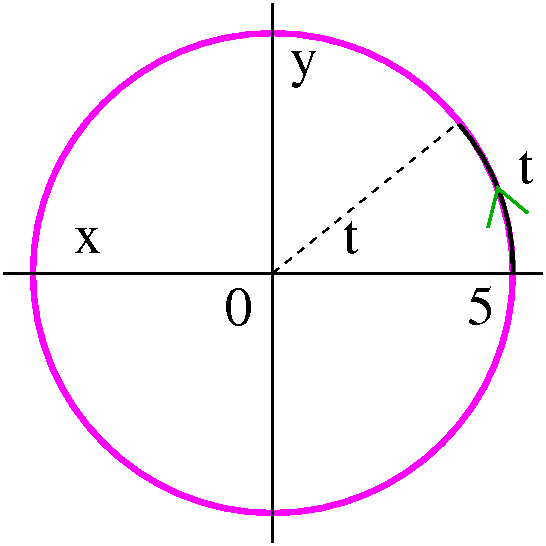
|
What if x(t)=5cos(t) and y(t)=3sin(t)? Then the
trig identity gives (after elimination of the parameter)
(x/5)2+(y/3)2=1 as the possible path of the
point. This is an ellipse centered at (0,0). Its wider part (total
length 1) is on the horizontal axis, as shown. The vertical extant of
the ellipse is 6.
So I attempted to create a moving image of this curve. I hope it is
helpful to you. The parameterization is by central angle. Speed
varies .... Originally, further comments followed, but these,
it turns out, were incorrect. I apologize. See the next lecture's
diary entry for more information.
| 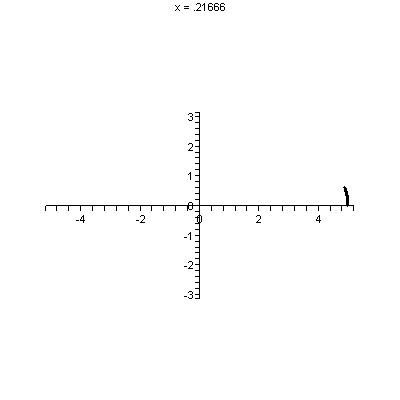
|
A bug drawing out a thread ...
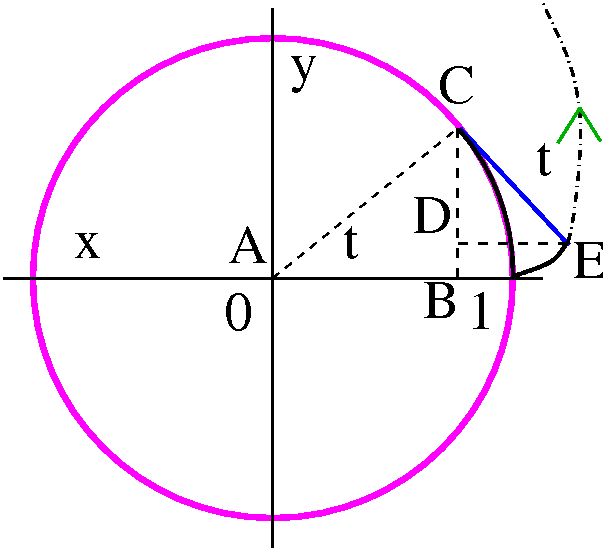 Thread is wound around the unit circle centered at the origin. A bug
starts at (1,0) and is attached to an end of the thread. The bug
attempts to "escape" from the circle. The bug moves at unit speed.
Thread is wound around the unit circle centered at the origin. A bug
starts at (1,0) and is attached to an end of the thread. The bug
attempts to "escape" from the circle. The bug moves at unit speed.
I would like to find an expression for the coordinates of the bug at
time t. Look at the diagram. The triangle ABC is a right triangle, and
the acute angle at the origin has radian measure t. The hypotenuse
has length 1, and therefore the "legs" are cos(t) (horizontal leg, AB)
and sin(t) (vertical leg, BC). Since the line segment CE is the bug
pulling away (!) from the circle, the line segment CE is tangent to
the circle at C. But lines tangent to a circle are perpendicular to
radial lines. So the angle ECA is a right angle. That means the angle
ECD also has radian measure t. But the hypoteneuse of the triangle ECD
has length t (yes, t appears as both angle measure and length
measure!) so that the length of DE is t sin(t) and the length of
CD is t cos(t).
The coordinates of E can be gotten from the coordinates of C and the
lengths of CD and DE. The x-coordinates add (look at the picture) and
the y-coordinates are subtracted (look at the picture). Therefore the
bug's path is given by x(t)=cos(t)+t sin(t) and
y(t)=sin(t)-t cos(t).
| t between 0 and 1 | t between 0 and 10
Note that the scale is changed! |
|---|
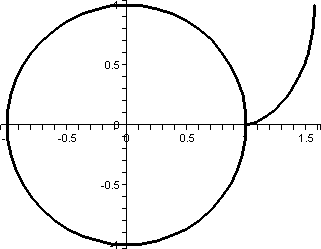 |
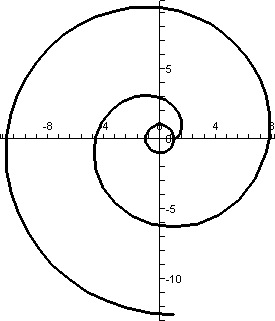 |
Finally to the right is an animated picture of the bug moving. Maybe
you can understand this picture better: maybe (!!).
This curve is more typical of parametric curves. I don't know any easy
way to "eliminate" mention of the parameter. This seems to be an
authentically (!) complicated parametric curve, similar to many curves
which arise in physical and geometric problems. It has an official
name. It is called the evolute of the circle.
| 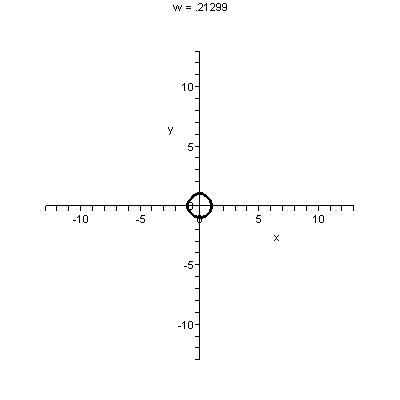
|
My favorite parametric curve
This is x(t)=1/(1+t2) and y(t)=t3-t. I tried to
analyze this curve a bit differently from the other examples by
separately considering the horizontal and vertical components.
| The horizontal control |
|---|
|
Here we consider x as a function of t. The function has even degree
and is therefore symmetric: if (t,x) is on the curve, so it
(-t,x). Actually, the function is relatively simple. Consider positive
t. As t increases, x decreases, and since 1+t2-->∞
x-->0. So we get a picture as shown below.
Since this represents the horizontal part of the motion described by
this parametric curve, the result is this in the (x,y) plane: the
point for large negative t starts close to the x-axis. Then as t
increases, it slowly moves right. At its largest it is 1 unit to the
right of the vertical axis. Then it slowly moves back towards the
vertical axis again.

|
| The vertical control |
|---|
|
In this case, I'm considering the y-component of the moving point. I
could think of this as the vertical control of some sort of scanning
machine. The function has odd degree and is antisymmetric (if (t,y) is
on the curve, then (-t,-y) is on the curve). It is a cubic polynomial
with three real roots, at 1, -1, and 0. The graph is shown to the
right.
The curve in the (t,y) plane starts very low left, then up, then down,
then up, way way up on the right.
But this is a description of the vertical motion. Now what could we
"see" in the (x,y) plane? The point
starts way way down (this is large negative y!), moves up,
bounces down, and then finally moves way way up.
|  |
|
 Combining these two motions can be difficult to do but with practice
you will find it easier. A part of the combined motion, the whole
parametric curve, is shown to the right. Indeed, it is a curve with a
self-intersection.
Combining these two motions can be difficult to do but with practice
you will find it easier. A part of the combined motion, the whole
parametric curve, is shown to the right. Indeed, it is a curve with a
self-intersection.
I don't know how to describe this curve accurately and efficiently
without the parametric "apparatus". The self-intersection occurs when
t=1 and t=-1 (that's where x=0 and y<1, as shown in the
picture). The point at which this occurs is (0,1/2).
Calculus?
Finally, very late in the lecture, I attempted some calculus. Here's
what I said.
Suppose we want to analyze what happens when the parameter changes
just a little bit, from t to t+Δt. Well, the point starts at
(f(t),g(t)). What can we say happens at
t+Δt? Well, f(t+Δt)≈f(t)+f´(t)Δt. Why is
this true? You can
think of this either 151 style as linear approximation, or from our
more sophisticated 152 approach, this is the constant and linear terms
in the Taylor series for f(t). Similarly for g(t) we know
g(t+Δt)≈g(t)+g´(t)Δt. Therefore the point in the
interval [t,t+Δt] moves from (f(t),g(t)) to
(approximately!)
(f(t)+f´(t)Δt,g(t)+g´(t)Δt). What is the slope of
the line segment connecting these points?
Slope
Take the difference in second coordinates divided by the difference in
the first coordinates. The result (there is a lot of cancellation) is
g´(t)/f´(t). If this were an xy curve, this would be noted
as dy/dx, the slope of the tangent line. In fact, people usually
remember the result in the following way:
dy dy/dt
-- = -----
dx dx/dt
and this can be used to get tangent lines (which I will do next time!).
Speed
Since Distance=Rate·Time, and in the time
interval [t,t+Δt] we move from (f(t),g(t)) to (approximately!)
(f(t)+f´(t)Δt,g(t)+g´(t)Δt), we can get the speed
(the Rate) by taking the distance between these points and dividing by
Δt. There is more cancellation here, and the result is
Speed=sqrt(f´(t)2+g´(t)2) or
___________
/(dx)2 (dy)2
Speed= / (--)+ (--)
/ (dt) (dt)
As you'll see, this is the sum of the squares of the
horizontal and vertical components of the velocity vector: it is,
in fact, the magnitude of the velocity vector.
Please: I will show you a few simple examples of this Wednesday, and
then go on to Polar Coordinates.
QotD
(More or less!) What is the state bird
of New Jersey? I will report on the answers soon. Next time we
will hand out (sigh) student evaluations. Come and write. SENATE, No. 241
STATE OF NEW JERSEY
--------
Introduced January 29, 1935
By Mr. KUSER
Referred to Committee on Miscellaneous Business
An Act to create a New Jersey State Bird
BE IT ENACTED by the Senate and General Assembly of the State of
New Jersey:
1. The Eastern Goldfinch is hereby designated as the New Jersey
State bird.
2. This act shall take effect immediately.
STATEMENT
The purpose of this act is to create a State bird. Forty-four
of the States have already designated State birds.
| Wednesday,
April 23 | (Lecture #25) |
|---|
QotD!!!
I asked at the beginning of class:
What is the derivative of 17(x2)?
What is the derivative of (17x)2?
I look forward with hope to reading the answers.
What we know about Taylor (o.k., Maclaurin) series so far
- ex=1+x+{x2/2}+{x3/6+...=∑n=0∞[xn/n!] valid for all x.
- sin(x)=x-[x3/3!]+[x5/5!]-[x7/7!]+[x9/9!]...=∑n=0∞(-1)n+1x2n+2/(2n+1)! valid for all x.
- cos(x)=1-[x2/2!]+[x4/4!]-[x6/6!]+[x8/8!]-[x10/10!]...=∑n=0∞(-1)n+1x2n/(2n)! valid for all x.
- 1/(1-x)=1+x+x2+x3+...=∑n=0∞xn
valid for |x|<1.
- ln(1+x)=x-[x2/2]+[x3/3]-[x4/4]+[x5/5]+...=∑n=1∞[(-1)n+1xn/n]
valid for |x|<1.
The first three were verified with Error Bound ideas, and the
last two used geometric series and then integrating a geometric
series. Today I will show you two more Taylor series "everyone" should
know. One comes from geometric series and one comes from Error
Bound analysis.
arctan
Let me try to find a Taylor series centered at 0 (a Maclaurin series)
for arctan. Well, the general Maclaurin series is
∑n=0∞[f(n)(0)/n!]xn
so we can just try to compute some derivatives and evaluate them at
0. Let's see:
n=0 f(x)=arctan(x) so f(0)=arctan(0)=0.
n=1 f´(x)=1/(1+x2) so
f´(0)=Stop this right now! Why?
Because this way is madness. Here is the 7th derivative of
arctan(x):
6 4 2
720 (7 x - 35 x + 21 x - 1)
------------------------------
2 7
(1 + x )
Does this look like something you want to compute?
Instead look at
1
----
1+x2
This sort of resembles the sum of a geometric series. We have two
"parameters" to play with, c, which is the first term, and r, which is
the ratio between successive terms. The sum is c/(1-r). If c=1
and r = –x2 then
1/(1+x2)=1/(1-{-x2}) is
the sum of a geometric series. So
1/(1+x2)=1-{x2}+{x2}2-{x2}3+{x2}4+...=1-x2+x4-x6+x8...
Now let's integrate:
∫1/(1+x2)dx=x-[x3/3]+[x5/5]-[x7/7]+[x9/9]...+C
The reason for the "+C" is that while we know that this series has
derivative equal to what we want, we don't know which specific
antiderivative will be arctan(x). This is really an initial value
problem and the +C represents the fact that we don't know the specific
solution. We need a value of arctan, and the simplest one is
arctan(0)=0. If we plug in x=0 to the series+C we get 0+C, so C should
be 0. And we have verified that (alternating signs, odd integer
powers, divided by odd integers [but not factorials!]):
- arctan(x)=x-[x3/3]+[x5/5]-[x7/7]+[x9/9]...=
∑n=0∞[(-1)2n+1x2n+1/(2n+1)]
Computing π
This series has been used to compute decimal approximations of
π. For example, if x=1, arctan(1)=π/4, so this must be
1-1/3+1/5-1/7+... but the series converges very slowly (for example,
the 1000th partial sum multiplied by 4 gives the
approximation 3.1406 for π which is not so good for all that
arithmetic!) . Here
is a history of some of the classical efforts to compute decimal
digits of π. You can search some of the known decimal digits of
π here. There are
more than a trillion (I think that is 1012) digits
of π's decimal expansion known. Onward! The methods used for such
computations are much more elaborate than what we have discussed.
Binomial series with m=1/3
One of Newton's most acclaimed accomplishments was the description of
the Maclaurin series for (1+x)m. Here is more
information. In class and here, I'll specialize by analyzing what
happens when m=1/3. We'll use a direct approach by taking lots of
derivatives and trying to understand
∑n=0∞[f(n)(0)/n!]xn.
- n=0 f(x)=(1+x)1/3 so that f(0)=(1+0)1/3=1.
- n=1 f´(x)=(1/3)(1+x)-2/3 so that
f´(0)=(1/3)(1+0)-2/3=(1/3).
- n=2 f´´(x)=(1/3)(-2/3)(1+x)-5/3 so that
f´´(0)=(1/3)(-2/3)(1+0)-5/3=(1/3)(-2/3).
- n=3 f(3)(x)=(1/3)(-2/3)(-5/3)(1+x)-8/3 so that
f(3)(0)=(1/3)(-2/3)(-5/3)(1+0)-8/3=(1/3)(-2/3)(-5/3).
- n=3 f(4)(x)=(1/3)(-2/3)(-5/3)(-8/3)(1+x)-11/3 so that
f(4)(0)=(1/3)(-2/3)(-5/3)(-8/3)(1+0)-11/3=(1/3)(-2/3)(-5/3)(-8/3).
Maybe that's enough. I hope that you see the pattern. What do we get
for the beginning of the power series? We should not forget to divide
by the appropriate factorials.
1+(1/3)x+[(1/3)(-2/3)/2]x2+[(1/3)(-2/3)(-5/3)/2·3]x3+[(1/3)(-2/3)(-5/3)(-8/3)/2·3·4]x4+...
I'll come back to the general ideas later, but let's see how to use
this in various ways.
Naive numerical use
So you want to compute (1.05)1/3? This is a doubtful
assumption, and anyway wouldn't you do a few button pushes on a
calculator? But let's see:
Suppose we use the first two terms of the series and let x=.05:
(1+.05)1/3=1+(1/3)(.05)+Error
What's interesting to me is how big the Error is. Of course, we
have the Error Bound, which states that
|Error|≤[K/(n+1)!]|x-a|n+1. Here, since the top
term in the approximation is the linear term, we have n=1. And a, the
center of the series, is 0, and x, where we are approximating, is
.05. Fine, but the most complicated part still needs some work. K is
an overestimate of the absolute value of the second derivative of f on
the interval connecting 0 and .05. Well (look above!) we know that
f(2)(x)=(1/3)(-2/3)(1+x)-5/3. We strip away the
signs (not the sign in the exponent, since that means something
else!). We'd like some estimate of the size of (2/9)(1+x)-5/3
on [0,.05]. Well, it is exactly because of the minus sign in
the exponent that we decide the second derivative is decreasing
on the interval [0,.05] and therefore the largest value will be at the
left-hand endpoint, where x=0. So plug in 0 and get
1/9(1+0)-5/3=2/9. This is our K. So the Error Bound
gives us [(2/9)/2!](.05)2, which is about .00027. We have
three (and a half!) decimal digits of accuracy in the simple
1+(1/3)(.05) estimate.
What if we wanted to improve this estimate? Well, we can try another
term. By this I mean use 1+(1/3)(.05)+[(1/3)(-2/3)/2](.05)2 as
an estimate of (1.05)1/3. How good is this estimate? Again,
we use the Error Bound:
|Error|≤[K/(n+1)!]|x-a|n+1. Now n=2 and a=0 and
x=.05, and K comes from considering
f(3)(x)=(1/3)(-2/3)(-5/3)(1+x)-8/3. We need to
look at (10/27)(1+x)-8/3 on [0,.05]. The exponent is again
negative (what an accident not -- these methods are actually
used and things should be fairly simple!) and therefore the function
is again decreasing and an overestimate is gotten by looking at the
value when x=0, so (10/27)(1+x)-8/3 becomes
(10/27)(1+0)-8/3=(10/27). Hey,
[K/(n+1)!]|x-a|n+1 in turn becomes
[(10/27)/3!](.05)3, about .000008, even better.
Approximating a function on an interval
People usually use the partial sums considered above in a more
sophisticated way. For example, consider replacing (1+x)1/3
by
T2(x)=1+(1/3)x+[(1/3)(-2/3)/2!]x2=1+(x/3)-(x2/9)
anywhere on the interval [0,.05]. I like polynomials, because
they can be computed just by adding and multiplying. The function
(1+x)1/3 has this irritating and weird exponent, that I, at
least, can't readily estimate. What about the error? The Error
Bound declares that an overestimate of the error is
[K/3!]|x-0|3. Now if 0<x<.05, then the largest
x3 can be is (.05)3. What about K? Again, we
look at the third derivative with the signs (not the exponent
sign!) dropped. This is (10/27)(1+x)-8/3 which we are
supposed to estimate for any x in [0,.05]. But since the third
derivative is still decreasing (-1/3<0) again the K is gotten by
plugging in x=0. Hey: the estimate is the same as what we had before,
about .000008. Below are some pictures illustrating what's going on.
| (1+x)1/3 & T2(x) on [0,.05] |
(1+x)1/3 & T2(x) on [0,2] |
|---|
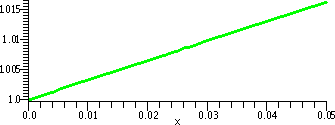 |
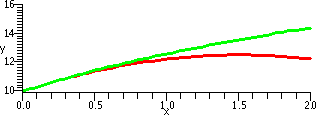 |
Comments
Yes, there really really are two curves
here. One, (1+x)1/3, is green and one,
T2(x)=1+(x/3)-(x2/9), is red. But the pixels in
the image overlay each other a lot, because the error, .000008, makes
the graphs coincide on the [0,.05] interval. There are only a finite
number of positions which can be colored, after all!
| Comments
This graph perhaps shows more about what's going on. The domain
interval has been changed to [0,2]. The K in the Error Estimate
is not changed, but the x's now range up to 2. So [K/3!]x3
becomes as a worst case estimate [(10/27)/3!]23, which is
about .49. You can see T2(x) revealed (!) as just a
parabola opening downward (hey, 1+(x/3)-(x2/9) has
–1/9 as x2 coefficient!). The two curves are
close near x=0, and then begin to separate as x grows larger.
|
Improving the approximation
The whole idea is maybe by increasing the partial sum (going to
Tn(x)'s with higher n's) we will get better
approximations. This is only usable if the approximations are easy to
compute (nice polynomials with simple coefficients) and if the error
estimates are fairly easy to do. This actually occurs so that people
use these ideas every day.
Binomial series in general
Suppose m is any number (yes: any
number). Then
- (1+x)m=1+mx+[m(m-1)/1·2]x2+[m(m-1)(m-2)/1·2·3]x3+[m(m-1)(m-2)(m-3)/1·2·3·4]x4+...,
valid for |x|<1.
People who use this frequently have developed special notation for the
weird coefficients which occur. So
[m(m-1)(m-2)(m-3)/1·2·3·4] is abbreviated as  . These are called binomial
coefficients.
. These are called binomial
coefficients.
How to gamble
I gave a wonderful and colorful presentation
about how to gamble. Well, I introduced certain basic language and
ideas. It ain't clear how wonderful and effective the presentation was
-- students may have some ideas. Even if you are not interested in
gambling, the same ideas and computations are used to investigate real
situations like the average life span of computer components or
stressed objects in structures or ... lots of things. Here are some notes I
wrote last year for a 152 class on this material.
The list ...
- ex=1+x+{x2/2}+{x3/6+...=∑n=0∞[xn/n!] valid for all x.
- sin(x)=x-[x3/3!]+[x5/5!]-[x7/7!]+[x9/9!]...=∑n=0∞(-1)n+1x2n+2/(2n+1)! valid for all x.
- cos(x)=1-[x2/2!]+[x4/4!]-[x6/6!]+[x8/8!]-[x10/10!]...=∑n=0∞(-1)n+1x2n/(2n)! valid for all x.
- 1/(1-x)=1+x+x2+x3+...=∑n=0∞xn
valid for |x|<1.
- ln(1+x)=x-[x2/2]+[x3/3]-[x4/4]+[x5/5]+...=∑n=1∞[(-1)n+1xn/n]
valid for |x|<1.
- arctan(x)=x-[x3/3]+[x5/5]-[x7/7]+[x9/9]...=
∑n=0∞[(-1)2n+1x2n+1/(2n+1)]
- (1+x)m=1+mx+[m(m-1)/1·2]x2+[m(m-1)(m-2)/1·2·3]x3+[m(m-1)(m-2)(m-3)/1·2·3·4]x4+...,
valid for |x|<1.
And read about Clever Hans -- I
did not invent this story!
| Monday,
April 21 | (Lecture #24) |
|---|
Art history majors don't need to know this!
but you should ... if you want to do anything
quantitative I could not be an art history major: my head
doesn't work like that. While grading the second examination, I came
across some errors which need admonishing (admonish "to advise
or caution").
Item 1 Please compute
(32+42)1/2. Since 32=9 and
42=16, their sum is 25 which has square root 5. The sum of
3 and 4 is 7. Notice that 5≠7. Therefore
(32+42)1/2 and 3+4 are not
equal. No amount of algebraic effort should be spent trying to
massage one into the other! Please!!!
Item 2 Consider the function 2x. Its graph looks
like this: 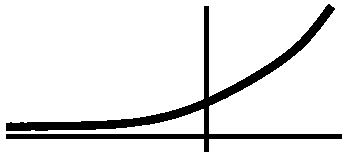 and so the slopes of
all of the lines tangent to the graph are positive -- they are
all tilted up. Now consider x2x-1. I think that when x=0
this function is 0. So there is no way that the derivative of
2x can be x2x-1! Please!!!
and so the slopes of
all of the lines tangent to the graph are positive -- they are
all tilted up. Now consider x2x-1. I think that when x=0
this function is 0. So there is no way that the derivative of
2x can be x2x-1! Please!!!
What is the derivative of 2x? Since 2x=(eln(2))x=e{ln(2)}x (repeated
exponentiations multiply!) we can differentiate using the Chain
Rule:
d/dx[e{ln(2)}x]=e{ln(2)}x(ln(2))=2xln(2).
So the derivative of 2x is 2xln(2).
And the derivative of 17x is 17xln(17).
And
the derivative of (1/134)x is
(1/134)xln(1/134).
And the derivative of
πx is πxln(π).
ETC.
Background
So far we've learned that partial sums of Taylor series are Taylor
polynomials. And by using the Error Bound for Taylor polynomials, we
see that some Taylor series converge, and they converge to the
functions which "created" them. Since a function has only one power
series centered at each point, and since power series can be added,
multiplied, divided, differentiated, integrated, and even more, well,
anything you do (if it is correct!) to a power series gets a new power
series, valid inside its radius of convergence.
So far
Our Error Bound analysis has given us these:
- ex=1+x+{x2/2}+{x3/6+...=∑n=0∞[xn/n!] valid for all x.
- sin(x)=x-[x3/3!]+[x5/5!]-[x7/7!]+[x9/9!]...=∑n=0∞(-1)n+1x2n+2/(2n+1)! valid for all x.
- cos(x)=1-[x2/2!]+[x4/4!]-[x6/6!]+[x8/8!]-[x10/10!]...=∑n=0∞(-1)n+1x2n/(2n)! valid for all x.
The quote I mentioned in class is this.
John von
Neumann, a great 20th century mathematician (and one of the
"inventors" of the digital computer and a major contributor to the
building of the first atomic bombs), is reported to have said,
In mathematics you don't
understand things. You just get used to them.
So we need to "get used to" infinite series.
Book problem: 10.7, #21
Use multiplication to find the first four terms in the Maclaurin
series for exsin(x).
You may, if you wish, start finding derivatives, evaluating them at 0,
and plug into the formula
∑n=0∞[f(n)(0)/n!]xn. I
don't want to because I would prefer to be LAZY. If asked to contribute to the design of
a car, would you first invent the wheel? Well, maybe, if
you could really conceive of a better wheel. The idea is to
take advantage of what's already done. Please!
exsin(x)=(1+x+{x2/2}+{x3/6}+...)(x-[x3/3!]+[x5/5!]...)=
(multiplying by 1)(x-[x3/6]+[x5/120])+
(multiplying by x)(x2-[x4/6]+[x6/24])+
(multiplying by x2/2)([x3/2]-[x5/12]+[x7/48])+
(multiplying
by x3/6)([x4/6]-[x6/36]+[x8/144])+
(multiplying
by
x4/24)([x5/24]-[x7/stuff]+[x9/more stuff])+
Now I'll collect terms, going up by degrees:
x+x2-[x3/6]+[x3/2]-[x4/6]
+[x4/6]]+[x5/120]-[x5/12]+[x5/24]
Stop! since I only need the "bottom" 4 (in degree). I did go on, past the x4 terms, since I noticed they canceled. I interpreted the problem as asking for the first 4 non-zero terms.
The hard computation is
[x5/120]-[x5/12]+[x5/24]. But
1/120-1/12+1/24=1/120-10/120+5/120=-4/120=-1/30. My answer is therefore
x+x2+[x3/3]-[x5/30].
Book problem: 10.7, #14
Find the Maclaurin series of cos(sqrt(x)). Since
cos(x)=1-[x2/2!]+[x4/4!]-[x6/6!]+[x8/8!]-[x10/10!]...=∑n=0∞(-1)n+1x2n/(2n)! I know that
cos(sqrt(x))=1-[(sqrt(x))2/2!]+[(sqrt(x))4/4!]-[(sqrt(x))6/6!]+[(sqrt(x))8/8!]-[(sqrt(x))10/10!]...=∑n=0∞(-1)n+1(sqrt(x))2n/(2n)!
and so
cos(sqrt(x))=1-[x/2!]+[x2/4!]-[x3/6!]+[x4/8!]-[x5/10!]...=∑n=0∞(-1)n+1xn/(2n)!,
and please be LAZY.
Book problem: 10.7, #19
Find the Maclaurin series of (1-cos(x2)/x. Since
cos(x)=1-[x2/2!]+[x4/4!]-[x6/6!]+...
I know that
cos(x2)=1-[x4/2!]+[x8/4!]-[x12/6!]+...
and
1-cos(x2)=[x4/2!]-[x8/4!]+[x12/6!]+...
so that
(1-cos(x2)/x=[x3/2!]-[x7/4!]+[x11/6!]+...
An integral
Consider ∫0.84cos(x3dx. I don't
know how to do this with FTC. That is, I can't find an antiderivative
of cos(x3) in terms of "familiar" functions. But what if
you really needed to know the value of this integral (hey, it's .81925
to 5 decimal place accuracy). We could use the Trapezoid Rule or
Simpson's Rule or ... Let me show you another way. Learning new tricks
is good, because sometimes the old tricks won't work so easily.
Since
cos(x)=1-[x2/2!]+[x4/4!]-[x6/6!]+[x8/8!]... I
know that
cos(x3)=1-[x6/2!]+[x12/4!]-[x18/6!]+[x24/8!]... and
we can find the antiderivative:
∫cos(x3)dx=∫1-[x6/2!]+[x12/4!]-[x18/6!]+[x24/8!]...dx=x-[x7/7·2]+[x13/(13·24)]-[x19/(19·720]+... and
now we evaluate |0.84 so
the value of the integral is
.84-[.847/7·2]+[.8413/(13·24)]-[.8419/(19·720]+...
This is ugly, but you should notice that it satisfies the Alternating
Series Test: the terms alternate in sign, their magnitudes decrease,
and the limit is 0. Therefore a partial sum is as accurate as the
first omitted term (that is emphatically not generally true for all
series!).
We computed [.8419/(19·720] and it was about
.000002. So the integral, to 5 decimal place accuracy, is
.84-[.847/7·2]+[.8413/(13·24)]. And
we computed this, and we got the predicted value, .81925.
Moral lesson?
Not clear to me there is a great moral lesson in this, but it is a
neat way, with not much work, to compute this particular integral. One
could even imagine doing this by hand if necessary (not really much
arithmetic). I would rather not compute a Trapezoid or Simpson's Rule
approximation by hand.
Logarithm
What the Maclaurin series of ln(x)? This is a trick question because
y=ln(x) looks like this  and the
limit of ln(x) as x-->0+ is -∞ so ln(x)
can't have a Taylor series centered at 0. What's a good place
to consider? Since ln(1)=0, we could center the series at 1. Most
people would still like to compute near 0, though, so usually the
function is moved instead! That is, consider ln(1+x) whose graph now
behaves nicely at 0
and the
limit of ln(x) as x-->0+ is -∞ so ln(x)
can't have a Taylor series centered at 0. What's a good place
to consider? Since ln(1)=0, we could center the series at 1. Most
people would still like to compute near 0, though, so usually the
function is moved instead! That is, consider ln(1+x) whose graph now
behaves nicely at 0  so we can
analyze it there.
so we can
analyze it there.
If f(x)=ln(1+x), I want to "find"
∑n=0&infin[f(n)(0)/n!]xn. Well,
f(0)=ln(1+0)=ln(1)=0, so we know the first term. Now
f´(x)=1/(1+x) so that ... wait, wait: remember to try to
be LAZY.
Look at
1
---
1+x
This sort of resembles the sum of a geometric series. We have two
"parameters" to play with, c, which is the first term, and r, which is
the ratio between successive terms. The sum is c/(1-r). If we take
c=1 and r=–x then 1/(1+x)=1/(1-{-x}) is the sum of a
geometric series. So
1/(1+x)=1-x+x2-x3+x4+...
Now let's integrate:
∫1/(1+x) dx=x-[x2/2]+[x3/3]-[x4/4]+[x5/5]+...+C
We need the "+C" because we don't officially know yet which
antiderivative we want to select to match up with ln(1+x). But just
test this at x=0. The function's value is ln(1)=0 and all of the
series terms are 0 except for the +C. So C must be 0.
ln(1+x)=x-[x2/2]+[x3/3]-[x4/4]+[x5/5]+...=&sumn=1∞[(-1)n+1xn/n]. This
is valid for |x|<1 certainly since that is the radius of
convergence of the geometric series we started with.
Computing with ln
What if x=-1/2 in the previous equation? Then ln(1-1/2)=ln(1/2)=-ln(2)
and this is approximately -69314. A friend of mine has just computed
&sumn=110[(-1)n+1(-.5)n/n]
and this turns out to be -.69306. We only get 3 decimal places of
accuracy. It turns out that this series converges relatively slowly
compared to the others we've already seen, which have the advantage of
factorials in the denominator. So this series is usually not directly
used for numerical computation, but other series related to it are used.
Book problem: 10.7, #9
Find the Maclaurin series of ln(1-x2).
Be LAZY. We know that
ln(1+x)=x-[x2/2]+[x3/3]-[x4/4]+[x5/5]+...=&sumn=1∞[(-1)n+1xn/n]. This
so we can substitute -x2 for x and get
ln(1-x2)=-x2-[(-x2)2/2]+[(-x2)3/3]-[(-x2)4/4]+[(-x2)5/5]+...=&sumn=1∞[(-1)n+1(-x2)n/n] and further
ln(1-x2)=-x2-[x4/2]-[x6/3]-[x8/4]-[x10/5]+...=-&sumn=1∞[(-1)n+1x2n/n] (valid for |x|<1).
Computing a value of a derivative
I know that the degree 8 term in the Maclaurin series for
ln(1-x2) is -[x8/4]. But it is also supposed to
be (by abstract "theory") [f(8)(0)/8!]x8. This means "clearly" (!!!) that
-1/4=[f(8)(0)/8!] and therefore f(8)(0)=-8!/4.
That's if you desperately wanted to know the value of the
derivative. An alternate strategy would be to compute the
8th derivative and evaluate it at x=0. Here is that
derivative:
6 8 4
10080 (28 x + x + 70 x + 28 x + 1)
- --------------------------------------
2 8
(-1 + x )
Second exams returned ...
The second exams were returned. Here is a version of that exam. An answer sheet was also distributed, and
information about the grades and
grading is available. Please let me know if you have questions
about the grading after you read the answer sheet and the grading
guide.
| Wednesday,
April 16 | (Lecture #23) |
|---|
A review session for the second exam. It featured the lecturer trying
to invent a suitable mixing problem "on the fly". That was sort of
fun. He also tried to present a useful example about the Error Bound.
| Monday,
April 14 | (Lecture #22) |
|---|
Power series ...
I recalled what had already been said about power series. Here we
go:
Definition
A power series centered at x0 (a fixed number) is an
infinite series of the form
∑n=0∞cnxn
where the x is a variable and the cn are some collection of
coefficients. It is sort of like an infinite degree
polynomial. Usually I (and most people) like to take x0 to
be 0 because this just makes thinking easier.
|
Calculus and power series
Hypothesis Suppose the power series
∑n=0∞an (x-x0)n
has some positive radius of convergence, R, and suppose that f(x) is
the sum of this series inside its radius of convergence.
Differentiation The series
∑n=0∞n an (x-x0)n-1
has radius of convergence R, and for the x's where that series
converges, the function f(x) can be differentiated,
and f´(x) is equal to the sum of that series.
Integration The series
∑n=0∞[an/(n+1)] (x-x0)n+1
has radius of convergence R, and for the x's where that series
converges, the sum of that series is equal to an indefinite integral
of f(x), that is
∫f(x)dx.
|
Convergence and divergence
A power series centered at x0 always has an interval of
convergence with the center of that interval equal to
x0. Inside the interval of convergence, the power series
converges absolutely and therefore converges. Outside the interval,
the power series diverges. The power series may or may not converge on
the boundary of the interval. The interval may have any length between
0 and ∞. Half the length of the interval is called the radius of
convergence.
|
If a function has a power series then ...
Suppose I know that f(x) is equal to a sum like
A+B(x-x0)+C(x-x0)2+D(x-x0)3+E(x-x0)4+...
and I would like to understand how the coefficients A and B and C and
D etc. relate to f(x). Here is what we can do.
Step 0 Since
f(x)=A+B(x-x0)+C(x-x0)2+D(x-x0)3+E(x-x0)4+...
if we change x to x0 we get f(x0)=A. All the
other terms, which have powers of x-x0, are 0.
Step 1a Differentiate (or, as I said in class, d/dx) the
previous equation which has x's, not x0's. Then we have
f´(x)=0+B+2C(x-x0)1+3D(x-x0)2+4E(x-x0)3+...
Step 1b Plug in x0 for x and get
f´(x0)=B. All the
other terms, which have powers of x-x0, are 0.
Step 2a Differentiate (or, as I said in class, d/dx) the
previous equation which has x's, not x0's. Then we have
f´´(x)=0+0+2C+3·2D(x-x0)1+4·3E(x-x0)2+...
Step 2b Plug in x0 for x and get
f´´(x0)=2C, so
C=[1/2!]f(2)(x0). All the other terms,
which have powers of x-x0, are 0.
Step 3a Differentiate (or, as I said in class, d/dx) the
previous equation which has x's, not x0's. Then we have
f(3)(x)=0+0+0+3·2·1D+4·3·2E(x-x0)1+...
Step 3b Plug in x0 for x and get
f(3))(x0)=3·2··1D=3!C
so D=[1/3!]f(3)(x0). All the other terms,
which have powers of x-x0, are 0.
ETC. Continue as long as you like. What we
get is the following fact: if
f(x)=∑n=0∞an(x-x0)n
then an=[f(n)(x0)/n!]. This is
valid for all non-negative integers, n. Actually, this formula is one
of the reasons that 0! is 1 and the zeroth derivative of f is f
itself. With these understandings, the formula works for n=0.
What this means is that
If a function is equal to a power series, that power series must
be the Taylor series of the function.
I hope you notice, please please please, that the partial sums of
the Taylor series are just the Taylor polynomials, which we studied earlier.
Usually I'll take x0=0, as I mentioned. Then the textbook
and some other sources call the series the Maclaurin series. A
useful consequence of this result (it will seem sort of silly!) is
that if a function has a power series expansion, then it has exactly
one power series expansion (because any two such series expansions are
both equal to the Taylor series, so they must be equal). This means if
we can get a series expansion using any sort of tricks, then that
series expansion is the "correct one" -- there is only one series
expansion. I'll show you some tricks, but in this class I think I will
just try some standard examples which will work relatively easily.
ex
I'll take x0=0. Then all of the derivatives of
ex are ex, and the values of these at 0 are all
1. So the coefficients of the Taylor series, an, are
[f(n)(x0)/n!]=1/n!. The Taylor series for
ex is therefore
∑n=0∞[1/n!]xn.
e-.3
Let's consider the Taylor series for ex when x=-.3. This is
∑n=0∞[1/n!](-.3)n. What
can I tell you about this? Well, for example, my "pal" could compute a
partial sum, say
∑n=010[1/n!](-.3)n. The result
is 0.7408182206. That's nice. But what else do we know? Well, this
partial sum is T10(-.3), the tenth Taylor polynomial for
ex centered at x0=0, and evaluated at -.3. The
Error Bound gives an estimation of |
T10(-.3)-e-.3|. This Error Bound asserts that this
difference is at most [K|-.3-0|11/11!], where K is some
overestimate of the 11th derivative of ex on the
interval between -.3 and 0. Well, that 11th derivative is
also ex. And we know that ex is increasing
(exponential growth after all!) so that for x's in the interval
[-.3,0], ex is at most e0=1, and we can take
that for K. So the Error Bound is 1|-.3-0|11/11!. Now
let's look at some numbers:
|-.3|11=0.00000177147 and 11!=39,916,800, and their
quotient is about 4·10-14.
This means that e-.3 and T10(-.3) agree at least
to 13 decimal places. Indeed, to 10 decimal places, e-.3 is
reported as 0.7408182206, the same number we had before. Wow? Wow!
Let's change 10 to n and 11 to n+1. Then
|Tn(-.3)-e-.3| is bounded by
K|-.3-0|n+1/(n+1)!. Here K=1 again because all of the
derivatives are the same, ex. Since
1|-.3-0|n+1/(n+1)!-->0 as n-->∞ what do we
know?
I think that the sequence {Tn(-.3)} converges, and
its limit is e-.3. Since this sequence of Taylor polynomial
values is also the sequence of partial sums of the series
∑n=0∞[1/n!](-.3)n, I
think that the series converges, and its sum is
e-.3. Therefore
e-.3=∑n=0∞[1/n!](-.3)n.
e.7
We tried the same thing when x=.7 and by the same thing, I think we
first examined T10(.7). This is
∑n=010[1/n!](.7)n. To 10
decimal places, this is 2.0137527069. We have information from the
Error Bound. It declares that |T10(.7)-e.7| is
no larger than K|.7-0|11/11!. Here K is an overestimate of
the 11th derivative, which is ex, on the
interval [0,.7]. The exponential function is (still!) increasing, so
the largest value is at x=.7. But I don't know e.7. I do
know it is less than e1 which I hardly know also. I will
guess that e<3. So a nice simple K to take is 3. Let me try
that. The Error Bound is less than 3|.7-0|11/11!. Let's do
the numbers here.
11!=39,916,800 (again) but .711=0.0197732674 (small, but
not as small as |-.3|11). The Error Bound
3|.7-0|11/11! is about 2·10-9, not quite
as small.
Now e.7, to 10 decimal places, is 2.0137527074 and this is
close enough to the sum value quoted before.
Again, go to n and n+1: |Tn(.7)-e.7| is less
than 3|.7-0|n+1/(n+1)!, and again, as n-->∞ this
goes to 0. Our conclusion is:
The sequence {Tn(.7)} converges, and
its limit is e.7. Since this sequence of Taylor polynomial
values is also the sequence of partial sums of the series
∑n=0∞[1/n!](.7)n, I
think that the series converges, and its sum is
e.7. Therefore
e.7=∑n=0∞[1/n!](.7)n.
e50
Just one more example partly because we'll see some strange
numbers. Let's look at T10(50)
which is
∑n=010[1/n!]50n.
This turns out to be (approximately!) 33,442,143,496.7672, a big
number. The Error Bound says that |T10(50)-e50|
is less than K|50-0|11/11! where K is the largest
ex can be on [0,50]. That largest number is e50
because ex is increasing. I guess e50 is less
than, say, 350, which is about
7·1023. I'll take that for K. Now how big is that Error?
K|50-0|11/11! still has 11! underneath but now the top is
growing also. This is approximately 9·1034, a sort
of big number.
The situation for x=50 may look hopeless, but it isn't really. To
analyze |Tn(50)-e50| we need to look at
K[(50)n+1/(n+1)!]. Here the fraction has power growth on
the top and factorial growth on the bottom. Well, we considered this before. I called it a
"rather sophisticated example". Factorial growth is faster eventually
than power growth. So this sequence will -->0 as
n-->∞. A similar conclusion occurs:
e50=∑n=0∞[1/n!](50)n.
In fact, e50 is 5.18470552858707·1021
while the partial sum with n=100,
∑n=0100[1/n!](50)n has value
5.18470552777323·1021: the agreement is not too bad,
relatively.
And generally for exp ...
It turns out that
∑n=0∞[1/n!]xn converges
for all x and its sum is always ex. The way
to verify this is what we just discussed. Most actual computation of
values of the exponential function relies on partial sums of this
series. There are lots of computational tricks to speed things up,
but the heart of the matter is the Taylor series for the exponential
function.
cosine
We analyzed cosine's Taylor polynomials, taking advantage of the
cyclic (repetitive) nature of the derivatives of cosine:
cosine-->-sine-->-cosine-->sine then back to cosine. At x=0,
this gets us a cycle of numbers: 1-->0-->-1-->0. The Taylor
series for cosine centered at 0 leads off like this:
1-[x2/2!]+[x4/4!]-[x6/6!]+[x8/8!]-[x10/10!]...
It alternates in sign, it has only terms of even degree, and each term
has the reciprocal of an "appropriate" factorial (same as the degree)
as the size of its coefficient.
cos(1/3)
How close is
1-[(1/3)2/2!]+[(1/3)4/4!]-[(1/3)6/6!]+[(1/3)8/8!]-[(1/3)10/10!]
to cos(1/3)? Here we sort of have two candidates because
T10(1/3) is the same as T11(1/3) since the
11th degree term is 0.
Error bound, n=10 So we have K|(1/3)-0|11/11!, where
K is a bound on the size of the 11th derivative of
cosine. Hey: I don't care much in this example, because I know that
this derivative is +/-cosine or +/-sine, so that I can take K to be
1. Now it turns out that (1/3)11/11! is about
1.4·10-14. This is tiny, but ...
Error bound, n=11 This is even better. So we have K|(1/3)-0|12/12!, where
K can again be taken as 1 (this is easier than exp!)
So (1/3)12/12! is about
4·10-15, even tinier.
Hey, cos(1/3)=0.944956946314738 and
T10(1/3)=0.944956946314734.
cosine and sine estimates
For both cosine and sine, the estimates are easy because K for both
can be taken to be 1. And the results are that the appropriate Taylor
series for both functions converge to the function values. That
is:
cos(x)=∑n=0∞(-1)n+1x2n/(2n)!
for all x. The first few terms look like 1-[x2/2!]+[x4/4!]-[x6/6!]+[x8/8!]-[x10/10!]...
sin(x)=∑n=0∞(-1)n+1x2n+2/(2n+1)!
for all x. The first few terms look like
x-[x3/3!]+[x5/5!]-[x7/7!]+[x9/9!]...
A series for cos(x3)
We can use the series we know to "bootstrap" and get other
series. That is, we build on known results. For example, since we know
that
cos(x)=1-[x2/2!]+[x4/4!]-[x6/6!]+[x8/8!]-[x10/10!]...
for all x, I bet
cos(x3)=1-[(x3)2/2!]+[(x3)4/4!]-[(x3)6/6!]+[(x3)8/8!]-[(x3)10/10!]...
which is
1-[x6/2!]+[x12/4!]-[x18/6!]+[x24/8!]-[x30/10!]...
and this is much easier than trying to compute derivatives of
cos(x3) which we would have to do to plug in the values of
the derivatives in the Taylor series. The Chain Rule makes things
horrible. For example, the fifth derivative of cos(x3) is
-243sin(x3)x10+1620cos(x3)x7+2160sin(x3)x4-360cos(x3)x
and that's fairly horrible.
How about x2cos(x3)?
Multiply the previous series by x2. The result is
x2cos(x3)=x2-[x8/2!]+[x14/4!]-[x20/6!]+[x26/8!]-[x32/10!]...
Wow?
QotD
What are the first four non-zero terms of the Taylor series for
x3e-2x centered at 0?
Since ex=1+x+x2/2+x3/6+... (3! is 6)
we know
e-2x=1-2x+(-2x)2/2+(-2x)3/6+...=1-2x+4x2/2-8x3/6+...=
=1-2x+2x2-4x3/3+...
and then we multiply by x3. The answer is
x3-2x4+2x5-4x6/3.
Maintained by
greenfie@math.rutgers.edu and last modified 4/14/2008.


 The rectangular graph of 1+sine, shown here, decreases
down to 0 and then increases to +1. The polar graph dips to 0 and then
goes back up to 1. The dip to 0 in polar form is geometrically a sharp
point! I used "!" here because I don't believe this behavior is easily
anticipated. The technical name for the behavior when r=3Pi/2 is
cusp.
The rectangular graph of 1+sine, shown here, decreases
down to 0 and then increases to +1. The polar graph dips to 0 and then
goes back up to 1. The dip to 0 in polar form is geometrically a sharp
point! I used "!" here because I don't believe this behavior is easily
anticipated. The technical name for the behavior when r=3Pi/2 is
cusp.

 The rectangular graph on the interval [0,2Pi] of sine moved up by 1/2
shows that this function is 0 at two values, and is negative between
two values. The values are where 1/2+sin(θ)=0 or sin(θ)=-1/2. The values of θ satisfying that equation in the
interval of interest are Pi+Pi/6 and 2Pi-Pi/6. The curves goes down to
0 distance from the origin at Pi+Pi/6, and then r is negative until
2Pi-Pi/6. The natural continuation of the curve does allow negative
r's, and the curve moves "behind" the pole, making a little loop
inside the big loop. Finally, at 2Pi-Pi/6, the values of r become
positive, and the curve links up to the start of the big loop.
The rectangular graph on the interval [0,2Pi] of sine moved up by 1/2
shows that this function is 0 at two values, and is negative between
two values. The values are where 1/2+sin(θ)=0 or sin(θ)=-1/2. The values of θ satisfying that equation in the
interval of interest are Pi+Pi/6 and 2Pi-Pi/6. The curves goes down to
0 distance from the origin at Pi+Pi/6, and then r is negative until
2Pi-Pi/6. The natural continuation of the curve does allow negative
r's, and the curve moves "behind" the pole, making a little loop
inside the big loop. Finally, at 2Pi-Pi/6, the values of r become
positive, and the curve links up to the start of the big loop.


 The
rectangular graph, shown here, has three pairs of ups and downs. The
polar trace covers the leaves twice. The six up-and-downs of
cos(3θ) (magically?) reduce to retracings of half of the
loops. I hope I made this evident. I introduced
some deliberate distortion in the second tracing. (!) Without
the distortion, the second tracing could not be seen at all, since the
pixels the "point" travels over and colors all had already been
colored.
The
rectangular graph, shown here, has three pairs of ups and downs. The
polar trace covers the leaves twice. The six up-and-downs of
cos(3θ) (magically?) reduce to retracings of half of the
loops. I hope I made this evident. I introduced
some deliberate distortion in the second tracing. (!) Without
the distortion, the second tracing could not be seen at all, since the
pixels the "point" travels over and colors all had already been
colored.

 The rectangular
graph. to the right, shows four bumps up and four bumps down. There
are no retracings of already colored points, so that the wiggles up
and down of cos(4θ) all result in 8 leaves.
The rectangular
graph. to the right, shows four bumps up and four bumps down. There
are no retracings of already colored points, so that the wiggles up
and down of cos(4θ) all result in 8 leaves.

 Area inside one petal of r=cos(3θ)
Area inside one petal of r=cos(3θ) Tangent lines
Tangent lines Now this does resemble what I know about the motion of a planet in
orbit. When it is far away from the center of the orbit, the planet
will have large potential energy and relatively small kinetic energy
(it will move slowly). This is near t=0 and t=π. When it is close
to the center of the orbit, the planet moves faster, and the kinetic
energy is larger, while the potential energy, measured by the work
needed to move closer/farther from the center, decreases.
Now this does resemble what I know about the motion of a planet in
orbit. When it is far away from the center of the orbit, the planet
will have large potential energy and relatively small kinetic energy
(it will move slowly). This is near t=0 and t=π. When it is close
to the center of the orbit, the planet moves faster, and the kinetic
energy is larger, while the potential energy, measured by the work
needed to move closer/farther from the center, decreases.
 The idea of polar coordinates
The idea of polar coordinates Fix a point (usually called "the center" or sometimes "the pole" and
in most common situations, the origin of the xy-coordinate
system. Also fix a direction -- if need this might be called "the
initial ray". Almost always this is the positive x-axis in an
xy-coordinate system. Then locate another point in the plane by giving
its distance from the center (called r) and by drawing the line
segment between the center and the point you are locating. Measure the
angle between that and the initial ray (note: counterclockwise is a
positive angle!): this is called θ. r and θ are the
polar coordinates of the point.
Fix a point (usually called "the center" or sometimes "the pole" and
in most common situations, the origin of the xy-coordinate
system. Also fix a direction -- if need this might be called "the
initial ray". Almost always this is the positive x-axis in an
xy-coordinate system. Then locate another point in the plane by giving
its distance from the center (called r) and by drawing the line
segment between the center and the point you are locating. Measure the
angle between that and the initial ray (note: counterclockwise is a
positive angle!): this is called θ. r and θ are the
polar coordinates of the point.
 Well, make the standard choices for "the pole" and "the initial
ray". Let's get polar coordinates (the values of r and θ) for
the point whose rectangular coordinates are x=sqrt(3) and y=1. Of
course this is not a random point (sigh). So we consider the picture,
and decide that the hypotenuse (r) should be 2 units long, and the
acute angle (θ) should be π/6. Fine.
Well, make the standard choices for "the pole" and "the initial
ray". Let's get polar coordinates (the values of r and θ) for
the point whose rectangular coordinates are x=sqrt(3) and y=1. Of
course this is not a random point (sigh). So we consider the picture,
and decide that the hypotenuse (r) should be 2 units long, and the
acute angle (θ) should be π/6. Fine.




 Example 1
Example 1





 Thread is wound around the unit circle centered at the origin. A bug
starts at (1,0) and is attached to an end of the thread. The bug
attempts to "escape" from the circle. The bug moves at unit speed.
Thread is wound around the unit circle centered at the origin. A bug
starts at (1,0) and is attached to an end of the thread. The bug
attempts to "escape" from the circle. The bug moves at unit speed.





 Combining these two motions can be difficult to do but with practice
you will find it easier. A part of the combined motion, the whole
parametric curve, is shown to the right. Indeed, it is a curve with a
self-intersection.
Combining these two motions can be difficult to do but with practice
you will find it easier. A part of the combined motion, the whole
parametric curve, is shown to the right. Indeed, it is a curve with a
self-intersection.


 and so the slopes of
all of the lines tangent to the graph are positive -- they are
all tilted up. Now consider x2x-1. I think that when x=0
this function is 0. So there is no way that the derivative of
2x can be x2x-1! Please!!!
and so the slopes of
all of the lines tangent to the graph are positive -- they are
all tilted up. Now consider x2x-1. I think that when x=0
this function is 0. So there is no way that the derivative of
2x can be x2x-1! Please!!!